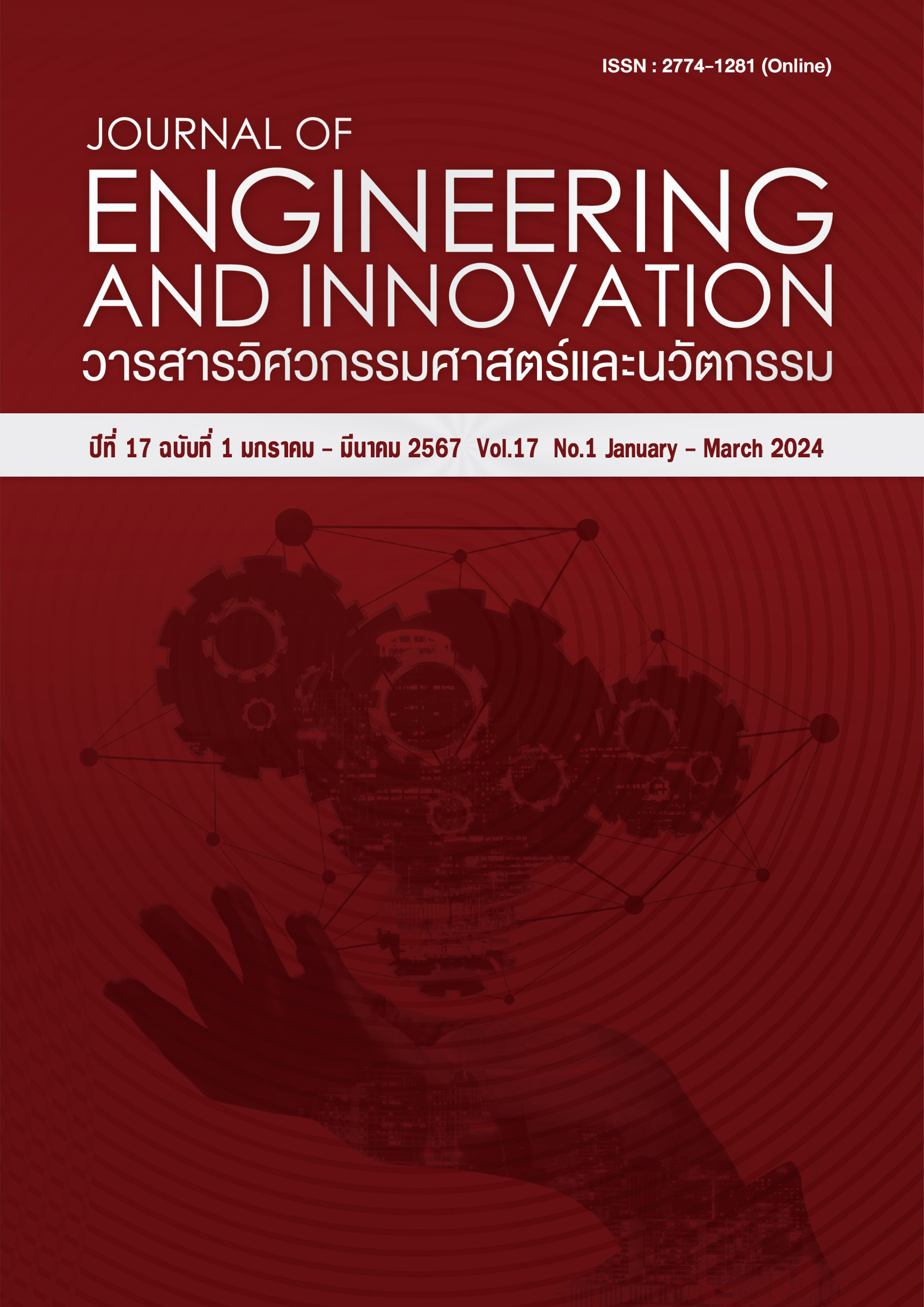Effects of glove use on grip strengths at different working postures
Main Article Content
Abstract
Gloves are one of the most widely used personal protective equipment in industrial and agricultural work fields. However, use of gloves may affect an ability of the hand. The purpose of this research was to study the effects of glove use on grip strengths at different working postures. The study was conducted with a sample group of 40 university students (20 males and 20 females) aged 18-22 years, average height 166.74 (±9.44) cm, average weight 63.52 (±19.34) kg. The experiments were first tested with bare hands against the use of three different types of cotton yarn knitted gloves: 1) non-patterned gloves, 2) rubber-dotted gloves, and 3) fully rubber-coated gloves. Grip strength was measured using a hand dynamometer in 3 postures: straight arm (180 degrees), elbow flexion (90 degrees) and shoulder flexion (45 degrees). Dominant and non-dominant hands are measured. The study found that the average grip strength of the bare hands of both hands was higher than when using gloves. In testing the dominant hand, it was found that the highest hand grip strength was the straight arm (29.3 kg), followed by the shoulder flexion (27.9 kg) and the elbow flexion (27 kg). The dominant hand test in all positions was higher than the non-dominant hand (11.5-12.5%). In addition, straight arm extension (180 degrees) was found to have the highest hand grip strength in both bare-handed and gloved use. It is found that, compared with bare hands, different types of gloves were associated with different reduction in the grip strength: 20.6-22.2% for fully-coated gloves and 8.4-9.9% for rubber-dotted gloves. Analyzing with the paired t-test, significant differences of resultant grip strengths were confirmed across the experimented postures and types of gloves. However, in male samples, there was no significant statistical evidence between the grip strength of bare hands and rubber-dotted gloved hands when the samples performed a particular posture with the elbow bent at 90°. Results from the experiments urge operators to be selective on glove use, leading to not only being able to use their hands effectively, but also to avoid any accidents that may be caused by hand fatigue.
Article Details
References
M. Z. Ramadan. The Effects of Industrial Protective Gloves and Hand Skin Temperatures on Hand Grip Strength and Discomfort Rating. International Journal of Environmental Research and Public Health. 2017; 14(12):1506.
วิทชย เพชรเลียบ และ วลัญชยา เขตบํารุง. ปัจจัยที่มีความสัมพันธ์กับพฤติกรรมการใช้อุปกรณ์คุ้มครองความปลอดภัยส่วนบุคคลของเกษตรกรอายุ 50 ปีขึ้นไป ตำบลพุดซา อำเภอเมือง จังหวัดนครราชสีมา. วารสารของสำนักงานป้องกันควบคุมโรคที่ 9 จังหวัดนครราชสีมา. 2565;28(1): 16-26.
ดิษฐพล ใจซื่อ และ เกษราวัลณ์ นิลวรางกูร. การดูแลตนเองของแรงงานเก็บขยะ. วารสารการพยาบาลและการดูแลสุขภาพ 2560;35(1): 37-45.
A. Muralidhar, R. R. Bishu, and M. S. Hallbeck. The development and evaluation of an ergonomic glove. Applied Ergonomics, 1999;30(6): 555–563.
J. Pollard, W. Porter, A. Mayton, X. Xu, and E. Weston. The effect of vibration exposure during haul truck operation on grip strength, touch sensation, and balance. International Journal of Industrial Ergonomics. 2017;57: 23–31.
A. Yu and S. Sukigara. Evaluation of the design and materials of anti-vibration gloves: Impact on hand dexterity and forearm muscle activity. Applied Ergonomics. 2022; 98: 103572
C. Zhao, K. W. Li, and C. Yi. Assessments of work gloves in terms of the strengths of hand grip, one-handed carrying, and leg lifting. Applied Sciences (Switzerland). 2021;11(18): 8294.
L. K. Sharma, M. K. Sain, and M. L. Meena. Analyzing the Effects of Industrial Protective Glove’s Material on Hand Grip Strength. in 3rd International Conference on Recent Innovations and Technological Development in Mechanical Engineering, ICRITDME 2020. 2022 : 237–245.
องุ่น สังขพงศ์ และ กลางเดือน โพชนา, การยศาสตร์และการประเมิน, สงขลา: คณะวิศวกรรมศาสตร์ มหาวิทยาลัยสงขลานครินทร์, 2556.
F. Tayyari and J. L. Smith, Occupational Ergonomics: Principles and applications. London, UK: Chapman & Hall, 1997.
K. Intaranont, S. Somnasaeng, P. Khokhajaikiat, and N. Chroenchai, Anthropometry and Physical Work of Agricultural and Industrial Populations in Northeast Thailand, USAID and Khon Kaen University, Bangkok, Thailand, Research report, Oct. 1991.
B. Wimer, T. W. McDowell, X. S. Xu, D. E. Welcome, C. Warren, and R. G. Dong. Effects of gloves on the total grip strength applied to cylindrical handles. International Journal of Industrial Ergonomic. 2010;40(5): 574–583.
นิวิท เจริญใจ. การออกแบบเชิงการยศาสตร์ สำหรับมีดตัดแต่งขิงดอง. สำนักงานคณะกรรมการวิจัยแห่งชาติ (วช.), 2546.
D. Langer, H. Melchior, and T. Mazor-Karsenty. Grip strength in healthy Israeli adults: Comparison to internationally reported normative data. Work. 2022;71(3): 787–794.
A. Alrashdan, A. M. Ghaleb, and M. Almobarek. Normative Static Grip Strength of Saudi Arabia’s Population and Influences of Numerous Factors on Grip Strength. Healthcare. 2021;9(12): 1647.
K. Baek, J.-T. Park, J. Hong, and K. Kwak. Hand grip strength for the working-age population in South Korea: Development of an estimation and evaluation model. International Journal of Industrial Ergonomics. 2023;94: 103398.
G. K. Singh and S. Srivastava. Grip strength of occupational workers in relation to carpal tunnel syndrome and individual factors. International Journal of Occupational Safety and Ergonomics. 2020;26(2): 296–302.
Y.-C. Ha, S.-C. Hwang, S.-Y. Song, C. Lee, K.-S. Park, and J.-I. Yoo. Hand grip strength measurement in different epidemiologic studies using various methods for diagnosis of sarcopenia: a systematic review. Eur Geriatr Med. 2018;9(3): 277–288.
R. Jain, K. B. Rana, and M. L. Meena. Effect of work experience and upper-limb muscle activity on grip strength of manual workers. International Journal of Occupational Safety and Ergonomics. 2023;29(1): 315 – 320.

